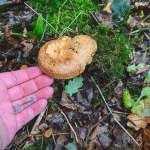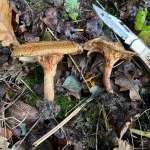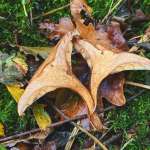Brown Rollrim - Paxillus involutus
At A Glance:
Brown Rollrim - Paxillus involutus
Other names: Common Rollrim, Poison Pax
Season: Summer, Autumn
Edibility: Poisonous
Fungi Type: Fungi With Gills, Mycorrhizal
Frequency: Very Common
Habitat: Deciduous woodland, Coniferous woodland, Parks, Gardens, Grassland, Heathland
Average width and height: w: 50 - 150mm h: 50 - 120mm
Key Features:
- Brown all over in varying shades.
- Smooth felt-like texture to cap when dry. Slimy when wet.
- Cap margin is rolled.
- Changes to a darker brown where bruised of cut
- Older caps often develop a funnel like with central depression and small boss. Pie-crust crimp patterning on cap edge
An inviting looking mushroom with some Agatha Christie-esque poisonous tricks up it’s sleeve, the Brown Rollrim is a common sight on foraging excursions, but one left out of the basket.
Table of Contents
Habitat/Season
Habitat: Deciduous woodland, Coniferous woodland, Parks, Gardens, Grassland, Heathland
Season: Jul, Aug, Sep, Oct, Nov
Preferring to grow under birch and other broadleaved trees, they can however be found almost anywhere else where there is suitable mycorrhizal partners including deciduous and coniferous woodland, parks, gardens and lawns.
Cap/Flesh/Fruiting Body
Average cap size: 50 - 150mm
Cap shape: convex, flat, depressed, umbonate
Cap colour: brown, ochre
Cap margin: inrolled
The colour can vary, but is always in the ‘brown’ category. Usually starting out lighter, before darkening with age.
Young species start with a convex cap shape which soon flattens out and becomes depressed, often with a small boss in the centre.
The cap edges, surprise surprise, roll inwards. Older ones often have a sort of ‘pie crust’ crimping pattern to the rim, as seen in the photos.
When dry, the cap is smooth, often with a fine felting. When wet, the surface feels slimy.
When bruised or cut, the gills/stem/flesh turn a darker brown almost immediately.
Gills/Spores
Gill density: crowded
Gill colour: pale ochre, brown
Gill attachment: decurrent
Spore print: brown, sienna
Spore shape: ellipsoidal, smooth
As with the cap, the gills turn from a lighter brown to a darker one with age, and can darken when bruised/damaged. You’ll often see flecks of ‘rust’ colouring the whole fungi, especially the gills. The gills are crowded and decurrent, meaning there’s a lot of them, and that they run down part of the stem.
Stem/Ring/Volva
Sharing the same colouring and bruising features as its cap and gills, the stem is also almost always curved and has a fairly uniform diameter up until the cap/gills.
Possible Confusions
At a glance, the Brown Rollrim could possibly be mistaken for one of the funnel shaped fungi (eg. oyster or chanterelle) or milkcap species.
Velvet Rollrim - grows on wood, usually on or near conifer stumps. Also considered unsafe.
Edibility/Taste/Smell
Unsafe to eat. Mild unpronounced mushroomy smell. Sharp acidic slightly mushroomy taste.
Notes
Etymology: Paxillus = peg or small stake, involutus = inrolled
Still eaten in some areas of the world. Prepared by boiling. Water thrown away before final cooking. This is considered the right approach like other species to remove the toxins. The soluble ones are mostly removed. However there are many other complex toxins that are not.
The link to it’s poisonous nature was not widely known as the effects are not felt until enough of the toxins have built up. This cumulative effect gives the temporal spacing of any patterns being observed by the eater.
The body builds a complex allergic reaction, which is revealed as “autoimmune haemolytic anaemia” - your body’s antibodies attack your red blood cells, causing severe potentially fatal effects.
Don’t eat these.
A high-profile case of paxillus poisoning occurred in 1944, when the famous German mycologist Julius Schäffer died after eating a meal made from these milkcap lookalikes. 1
References
Mushrooms and other fungi of Great Britain & Europe - Roger Phillips
Mushrooms and Toadstools of Britain and Ireland - Blacks Nature Guides







